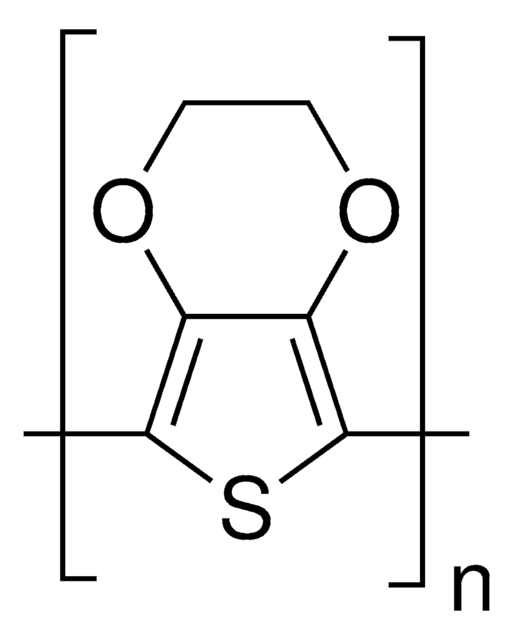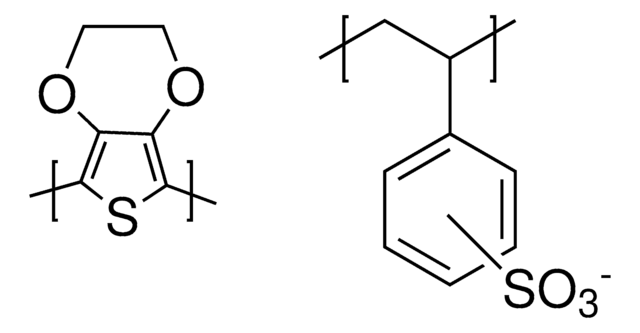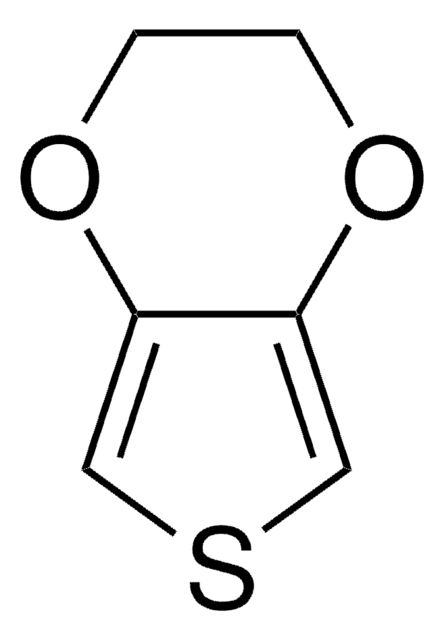655201
PEDOT:PSS
high-conductivity grade, 3.0-4.0% aqueous dispersion
Sinónimos:
PEDOT:PSS, Poly(2,3-dihydrothieno-1,4-dioxin)-poly(styrenesulfonate)
About This Item
Productos recomendados
Nombre del producto
Poly(3,4-ethylenedioxythiophene)-poly(styrenesulfonate), high-conductivity grade, 3.0-4.0% in H2O
Quality Level
greener alternative product characteristics
Design for Energy Efficiency
Learn more about the Principles of Green Chemistry.
sustainability
Greener Alternative Product
concentration
3.0-4.0% in H2O
resistance
1500 Ω/sq, 4 point probe measurement of dried coating based on initial 6μm wet thickness.
500 Ω/sq, 4 point probe measurement of dried coating based on initial 18μm wet thickness.
pH
1.5-2.5 (25 °C, dried coatings)
conductivity
>200 S/cm
viscosity
10-30 cP(20 °C)
density
1.011 g/cm3 (dried coatings)
greener alternative category
storage temp.
2-8°C
¿Está buscando productos similares? Visita Guía de comparación de productos
Categorías relacionadas
General description
Application
Packaging
signalword
Danger
hcodes
Hazard Classifications
Eye Dam. 1 - Skin Corr. 1
Storage Class
8B - Non-combustible corrosive hazardous materials
wgk_germany
WGK 3
flash_point_f
Not applicable
flash_point_c
Not applicable
ppe
Faceshields, Gloves, Goggles, type ABEK (EN14387) respirator filter
Elija entre una de las versiones más recientes:
¿Ya tiene este producto?
Encuentre la documentación para los productos que ha comprado recientemente en la Biblioteca de documentos.
Los clientes también vieron
Artículos
In the emerging field of organic printable electronics, such as OLEDs and organic photovoltaics (OPVs), there is a significant need for improved organic conducting and semiconducting materials. This paper reports our recent progress in two fields: 1) the development of solvent-based dispersions of the intrinsically conducting polymer (ICP) poly(3,4- ethylenedioxythiophene) (PEDOT) and 2) the synthesis of new electron-deficient (n-type) semiconducting polymers.
Conducting polymers such as polyaniline, polythiophene and polyfluorenes are now much in the spotlight for their applications in organic electronics and optoelectronics.
Find advantages of inorganic interface layer inks for organic electronic & other applications.
Progress in Organic Thermoelectric Materials & Devices including high ZT values of >0.2 at room temperature by p-type (PEDOT:PSS) & n-type (Poly[Kx(Ni-ett)]) materials are discussed.
Global Trade Item Number
| Número de referencia del producto (SKU) | GTIN |
|---|---|
| 655201-25G | 4061832733128 |
| 655201-5G | 4061832733135 |
Nuestro equipo de científicos tiene experiencia en todas las áreas de investigación: Ciencias de la vida, Ciencia de los materiales, Síntesis química, Cromatografía, Analítica y muchas otras.
Póngase en contacto con el Servicio técnico







